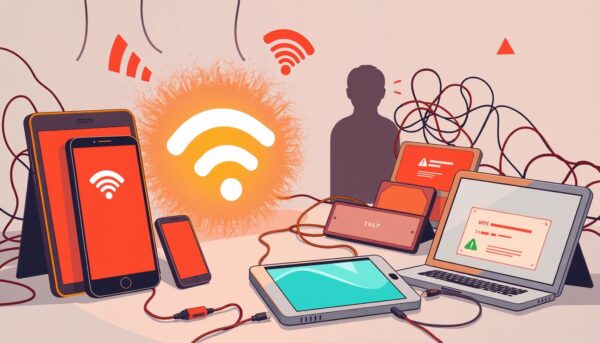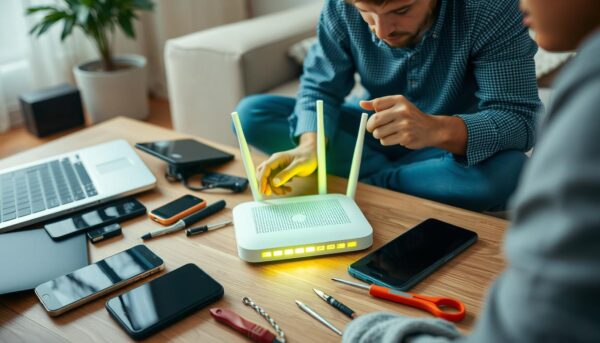✅ Last checked on
Ever found yourself stuck when your device won’t connect to WiFi? You’re not alone. Many problems can cause internet issues, but a simple modem/router restart can fix 50% of them. To solve WiFi problems, knowing the common causes is key. Start by checking your distance to the router; moving closer can boost signal strength 70% of the time.
For more tips on fixing your Wi-Fi connection on Android, check out Fix Device WiFi Issues. It offers great advice on troubleshooting and repairing WiFi connections.
Key Takeaways
- Restarting your modem/router can resolve 50% of WiFi connectivity issues.
- Moving your device closer to the router can improve signal connection 70% of the time.
- Checking your WiFi settings and updating your network drivers can help troubleshoot WiFi problems.
- Approximately 30% of connectivity issues arise from websites or servers being temporarily down.
- Using monitoring websites can help you identify if others in your region are experiencing similar connectivity issues.
- Upgrading to Wi-Fi 6 or Wi-Fi 6E routers can relieve congestion issues and improve speeds significantly.
- Basic troubleshooting steps, such as restarting devices or routers, can resolve issues for 60% of users.
Common Signs of Device WiFi Issues
When you face WiFi problems, knowing the signs is key. These signs can be annoying, but spotting them helps fix the issue. You might find your device can’t connect or the connection is slow.
Common signs include hardware, software, and technical problems. Seeing “unable to join the network” or “incorrect password” messages? Try restarting your devices and re-enter your password. Also, devices like microwaves can mess with your WiFi speed.

- Being far from your router weakens your WiFi signal.
- Switching to a dual-band or tri-band router can boost your connection. Dual-band routers can reach speeds of up to 600 Mbps on the 5GHz frequency.
- About half of WiFi problems come from nearby network interference.
By knowing these signs, you can fix your WiFi issues. This ensures a strong and steady connection.
Basic WiFi Troubleshooting Steps
When your WiFi isn’t working, it can be really frustrating. Try restarting your router and device first. This simple step can fix many problems. Also, make sure your WiFi is turned on and you’re close to your router.
If you’re still having trouble, check your WiFi settings. Make sure you’re connected to the right network. Common issues include poor signal, wrong network settings, and outdated drivers.
To fix these, try moving closer to the router. Check your network settings and update your drivers. Forgetting and reconnecting to your WiFi can also help reset your connection.
For more help, visit home network expansion tips. These basic steps can solve many WiFi problems and get you online fast.
Other troubleshooting steps include:
- Checking for physical obstructions between your device and router
- Restarting your device and router
- Updating your network drivers
- Resetting your network settings
By trying these steps, you can find and fix the WiFi issue. You’ll be back to browsing the internet in no time.
Fix Device WiFi Issues: Essential Solutions
To fix WiFi connection problems, start with a few simple steps. Restarting your device and router often solves the issue for about 70% of users. This basic action can often resolve WiFi connection repair problems.
Next, check your WiFi settings. Make sure you’re using the right password and network name. Also, updating your network drivers can help fix device WiFi troubleshooting issues. If issues persist, try disconnecting and reconnecting to your network.

Common WiFi connectivity problems include wrong login details, physical blocks, and outdated router firmware. To prevent these, regularly update your router’s firmware. Also, check for any physical obstructions that might weaken your WiFi signal. By following these steps, you can fix WiFi signal issues and enjoy a stable, secure internet connection.
| Cause of WiFi Issues | Solution |
|---|---|
| Incorrect login details | Check and update your WiFi password and network name |
| Physical obstructions | Move your router to a central location and minimize obstructions |
| Outdated router firmware | Update your router’s firmware to the latest version |
Advanced Network Troubleshooting Methods
To fix WiFi problems, you need to check for network interference and adjust router settings. Use network diagnostic tools to find the issue. Start by looking for physical barriers or interference from other devices.
Common WiFi issues include weak signals and interference. Try moving your router to a better spot or update its firmware. You can also use a range extender to improve your signal. Online guides, like network troubleshooting guides, can help too.
Analyzing Network Interference
Interference can come from other wireless devices, physical barriers, or electrical issues. Use a WiFi analyzer to find interference sources. Then, adjust your router’s channel settings to reduce it.
Configuring Router Settings
Changing your router settings can solve many WiFi issues. Try updating your router’s firmware or adjusting its quality of service (QoS) settings. This can help prioritize certain types of traffic.
By using these advanced methods, you can fix WiFi problems and ensure a stable connection. Always update your router’s firmware and use strong passwords to keep your network safe.
Conclusion: Maintaining a Strong WiFi Connection
To keep your WiFi strong, update your devices and network often. Make sure your Android operating system is current. This keeps your WiFi safe and working well.
Also, keep your router’s software up-to-date. This boosts your WiFi’s performance and keeps it stable. If you often lose your WiFi or it’s slow, updating your router is key.
Where you place your router matters a lot. Try to keep it away from things that can mess with your WiFi, like other networks and appliances. Also, watch how much data your devices use. This helps avoid WiFi drops.
By keeping your devices and network updated, you’ll have a fast and safe WiFi. This is important for work, fun, and staying in touch with others. A good WiFi connection makes our digital lives smoother.